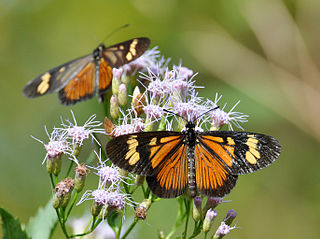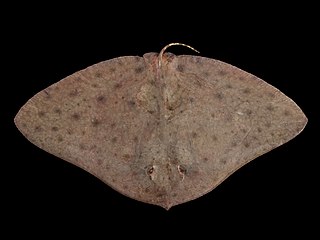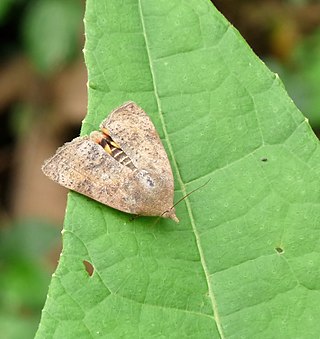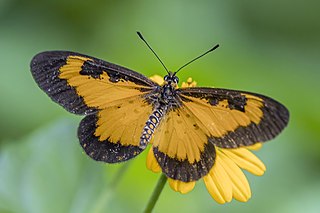
The Heliconiinae, commonly called heliconians or longwings, are a subfamily of the brush-footed butterflies. They can be divided into 45–50 genera and were sometimes treated as a separate family Heliconiidae within the Papilionoidea. The colouration is predominantly reddish and black, and though of varying wing shape, the forewings are always elongated tipwards, hence the common name.

Actinote is a genus of butterflies from South America of the subfamily Heliconiinae in the family Nymphalidae. Males interact with or without physical contact to contest the possession of mating sites. The winner in such interactions often has larger body size and is the individual that previously occupied the territory.

The butterfly rays are the rays forming the genus Gymnura and the family Gymnuridae. They are found in warm oceans worldwide, and occasionally in estuaries.

Paratrechina is one of seven ant genera in the Prenolepis genus-group from the subfamily Formicinae. Six species are included in Paratrechina; one of which, the longhorn crazy ant, is a widespread, pantropical pest.

The Adelidae or fairy longhorn moths are a family of monotrysian moths in the lepidopteran infraorder Heteroneura. The family was first described by Charles Théophile Bruand d'Uzelle in 1851. Most species have at least partially metallic, patterned coloration and are diurnal, sometimes swarming around the tips of branches with an undulating flight. Others are crepuscular and have a drab coloration. Fairy longhorn moths have a wingspan of 4–28 millimeters, and males often have especially long antennae, 1–3 times as long as the forewing.

Hyblaeidae are the "teak moths", a family of insects in the Lepidopteran order. The two genera with about 18 species make up one of the two families of the Hyblaeoidea superfamily, which in the past has been included in the Pyraloidea. Recent phylogenetic studies find varying relationships of Hyblaeoidea among Ditrysian Lepidoptera: Mutanen et al. (2010) find the superfamily to group either with Pyraloidea, or – more often – with Thyridoidea or butterflies. The results of Wahlberg et al. (2013) and Heikilä et al. (2015) indicate a sister-group relationship with Pyraloidea.

Acraea acerata, the falls acraea or small yellow-banded acraea, is a butterfly in the family Nymphalidae. It has an extensive range in sub-Saharan Africa.

Acraea bonasia, the bonasia acraea, is a butterfly in the family Nymphalidae which is native to the African tropics and subtropics.
Acraea burgessi is a butterfly in the family Nymphalidae. It is found in Uganda (Kigezi) and the Democratic Republic of the Congo.

Acraea necoda is a butterfly in the family Nymphalidae. It is found on the central and northern plateau in Ethiopia.
Pachymerium tabacarui is a species of centipede in Geophilidae family that is endemic to Romania. The original description of this species is based on a female specimen from the Carpathians measuring 15 mm in length with 53 pairs of legs. Some authorities consider this description consistent with a juvenile specimen of P. ferrugineum and therefore deem P. tabacarui to be a junior synonym of that species. A more recent review of this description suggests that P. tabacarui is a junior synonym of Geophilus flavus rather than P. ferrugineum. Extensive investigations in the Carpathian region have failed to collect any more specimens.

Geophilidae is a family of soil centipedes in the superfamily Geophiloidea and the order Geophilomorpha. In 2014, a phylogenetic analysis based on morphological and molecular data found this family to be polyphyletic. To avoid this polyphyly, authorities dismissed the families Aphilodontidae, Dignathodontidae, Linotaeniidae, and Macronicophilidae, which are now deemed to be junior synonyms for Geophilidae. Authorities also moved some genera from Geophilidae to form the family Zelanophildae in order to avoid the polyphyly of the family Geophilidae. The family Geophilidae now includes more than 650 species in more than 120 genera. This family has a cosmopolitan distribution, with species found almost worldwide.

Actinote rufina is a species of butterfly of the genus Actinote. The species is endemic to Peru, and has been sparsely documented in mountains west of the Madre de Dios River in Bolivia.

Actinote parapheles is a species of butterfly of the genus Actinote. The species has a maximum wingspan of ~55 millimeters.

Actinote stratonice is a species of butterfly of the genus Altinote.

Actinote ozomene is a species of butterfly in the genus Altinote. The species has been documented in Honduras, Nicaragua and El Salvador.

Actinote zikani is an extremely rare species of butterfly belonging to the family Nymphalidae, the subfamily Heliconiinae and the genus Actinote, endemic to Brazil. Its typical habitat is the Brazilian Atlantic forest at approximately 1,000 meters altitude, in the Serra do Mar. Considered extinct after 1981, the species was rediscovered in 1991 in the state of São Paulo, in the southeast of the country.














